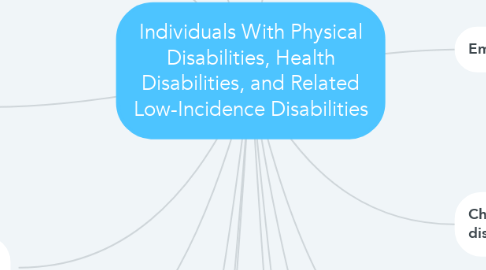
1. Prevalence
1.1. During the 2013/14 school year, in the area of physical and health disabilities, a total of 1,005,712 school-age children received services across:
1.1.1. traumatic brain injury- 23,311
1.1.2. orthopedic impairment- 52,629
1.1.3. multiple disabilities- 122,800
1.1.4. other health impairment- 806,972
2. Etiology
2.1. Varies greatly according to the specific disease or disorder.
2.2. Some of the most common: genetic and chromosomal defects, teratogenic causes, prematurity and complications of pregnancy, and acquired cases.
3. Characteristics of orthopedic impairment
3.1. Neuromotor Impairments
3.1.1. Cerebral Palsy
3.1.2. Spina Bifida
3.2. Degenerative Diseases
3.2.1. Duchenne muscular dystrophy
3.3. Musculoskeletal Disorders
3.3.1. Juvenile Idiopathic Arthritis
3.3.2. Limb Deficiency
4. Characteristics of traumatic brain injury
4.1. Temporary or permanent injury to the brain from acquired causes; it does not include congenital or degenerative conditions or birth trauma.
4.1.1. car accidents
4.1.2. accidental falls
4.1.3. gunshot wounds to the head
5. Characteristics of deaf-blindness
5.1. This is an extremely heterogeneous population varying tremendously in individual needs, abilities, and educational requirements.
5.1.1. speech and language impairments
5.1.2. behavioral and social difficulties
5.1.3. difficulties navigating the environment
6. Meeting educational needs
6.1. Physical/Health Monitoring
6.1.1. it is the responsibility of teachers and school officials to maintain a safe, healthy environment for their students
6.1.2. good communication and collaboration with the nurse, sped teacher, parents, and team will be important in planning for any anticipated problems that might arise
6.2. Adaptions
6.2.1. several adaptions may be needed to ensure that students with physical or health impairments are getting what they need to succeed in school
6.2.2. using a checklist helps ensure that a variety of adaptions have been considered and that everyone is using the same adaptations across environments
6.3. Specialized Instructional strategies
6.3.1. teachers need to know such strategies that include using special techniques for teaching phonics to students with complex communication needs, adapting assessment procedures, utilizing the student's reliable means of response, using alternative approaches for learning the writing process when alternative-access keyboarding is slow, and supporting chronically ill and terminally ill children
6.3.2. teachers also need to know how to implement specialized strategies to prevent communication breakdowns
6.4. Specialized Expanded Curriculum
6.4.1. the IEP team will determine the appropriate goals for a student with a physical or health disability
6.4.2. areas include social skills, vocational skills, community skills, mobility skills, and leisure skills
7. Diversity issues
7.1. lack of cultural bias in diagnosis
7.2. cultural differences in coping with illness and disability
8. Trends, issues, and controversies
8.1. there are 3 major issues in the field of physical disabilities, health disabilities, and related low-incidence disabilities
8.1.1. assessing capabilities and needs of students with very severe physical disabilities
8.1.2. provision of specialized technology, adaptations, and instructional strategies
8.1.3. selection of appropriate curriculum
9. Defining the meaning
9.1. CATEGORIES:
9.1.1. physical impairments: orthopedic impairment, multiple disabilities, and traumatic brain injury
9.1.2. health disabilities: other health impairment
9.1.3. loss of both vision and hearing: deaf-blindness
9.2. According to The United States Department of Education IDEA 2004 Individuals with Disabilities Education Act, a physical disability is categorized under "orthopedic impairment" and defined as: "A severe orthopedic impairment that adversely affects a child's educational performance. The term includes impairments caused by a congenital anomaly, impairments caused by disease (e.g., poliomyelitis, bone tuberculosis), and impairments from other causes (e.g., cerebral palsy, amputations, and fractures or burns that cause contractors)."
9.3. Other health impairment is defined by IDEA as: "Having limited strength, vitality, or alertness, including a heightened alertness to environmental stimuli, that results in limited alertness with respect to the educational environment, that-- (i) Is due to chronic or acute health problems such as asthma, attention deficit disorder or attention deficit hyperactivity disorder, diabetes, epilepsy, a heart condition, hemophilia, lead poisoning, leukemia, nephritis, rheumatic fever, sickle cell anemia, and Tourette syndrome; and (ii) Adversely affects a child's educational performance".
10. Emergence of public education
10.1. It was not until the 1900s that public schools for "crippled children" were established.
10.2. These schools permitted expensive equipment to be centrally located and enabled highly trained professionals to work with these children.
11. Characteristics of multiple disabilities
11.1. Two or more disabilities whose combination usually creates an interactional, multiplicative effect rather than just an additive one
11.1.1. Behavior disorders and muscular dystrophy
11.1.2. Cerebral palsy and seizures
11.1.3. Deafness and AIDS
11.1.4. Intellectual disability and spina bifida
11.1.5. Learning disabilities and asthma
12. Characteristics of other health impairments
12.1. Major Health Impairments
12.1.1. Seizure Disorders
12.1.2. Asthma
12.2. Infectious Diseases
12.2.1. Acquired immune deficiency syndrome (AIDS)
13. Assessment
13.1. Medical evaluation: physician confirms diagnosis of physical or health condition
13.2. Educational evaluations: team determines if the disability negatively impacts educational performance
13.3. Students with deaf-blindness: developmental, rather than standardized, assessments are used
14. Transitioning into adulthood
14.1. Career preparation
14.1.1. Preparation for employment includes considerations of supported employment or job coaching. Unemployment rates for people with physical and health disabilities remain dismally high.
14.2. College
14.2.1. Colleges and universities typically offer accommodations and accessibility support for students with physical or health disabilities although students may be reluctant to leave a familiar environment.
14.3. Technology
14.3.1. Technology has made many jobs available for individuals with physical and health disabilities.
14.4. Adulthood
14.4.1. Many adults with physical or health disabilities or related low incidence disabilities successfully transition into the adult world.
14.4.2. Community acceptance and supports are essential.
14.4.3. Many disabilities within this category may shorten the lives of the individuals and they will need to deal with this knowledge with their families.

